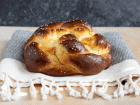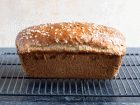
In a rush? You can skip to my 50/50 Wheat and Rye Sourdough Bread Recipe at my Tumblr. Or you can jump to my Just the Basics section.
I love my artisan-style whole wheat bread recipe. I enjoy the chewy texture and love making it for sandwiches.
But the other day, I almost ran out of wheat flour and didn’t have time to grind more. The only other flour I had available was some leftover rye flour from when I made some honey wheat and rye sandwich bread a few months ago.
I really wanted to make artisan-style bread, and since I had success in the past with wheat and rye bread together, I decided to experiment with a 50/50 blend of wheat and rye flours.
And this is what I ended up with.

Slow Proofed to Perfection
Of course, it took me a few tries to get the rise time just right with this recipe.
My whole wheat artisan-style loaf needed a long, slow fermentation to give the gluten plenty of time to develop. But rye flour is far more reactive and volatile than whole wheat flour.
The first time I made the recipe, my wheat and rye sourdough proofed much faster than I had expected and it almost overwhelmed my banneton basket. I baked it anyway, just to see what would happen, and much to my surprise, I still ended up with a gorgeous ear and a rich flavor that left me craving more.
With a little more experimenting, I found a good balance of water, salt, caraway seed, and fermentation to ensure the best results.

High Hydration for a Softer Texture
My 50/50 wheat and rye sourdough bread recipe uses a high hydration to ensure the bread stays nice and fluffy. It’s the perfect base for pastrami, Reuben, and similar deli-style sandwiches.
To make things easier for you, I’ve provided pictures on how to work with high hydration bread. However, if you’re a beginning baker, you may still find this recipe too difficult, as 90% hydration dough is very wet and sticky, and it takes a confident hand to shape properly.
If you’re just starting out with artisan-style loaves, I suggest hoping on over to my white, wheat, and rye bread recipe instead, as it only uses a 75% hydration. When you’ve got that recipe mastered, then come back and give this one a try.
Time
Prep time: 30 to 40 Minutes
Rise time: 18 Hours
Cook time: 45 Minutes
Total time: 3+ Days
Ingredients
To make this wheat and rye sourdough bread, you’ll need a strong, active starter fed to 100% hydration (1:1 ratio of water to flour). Since my starter isn’t as active as it could be, I make a levain the night before I mix my bread. Here’s what you’ll need for both the levain and the bread dough.
Levain
- 2 Grams (1/2 Teaspoon) Sourdough Starter
- 18 Grams (1 Tablespoon and 1 Teaspoon) Whole Wheat Flour
- 20 Grams (1 Tablespoon and 1 Teaspoon) Water
Bread Dough
- 250 Grams (2 Cups and 1 Tablespoon and 3/4 Teaspoon) Whole Wheat Bread Flour *
- 250 Grams (2 1/4 Cups and 3 Tablespoons) Rye Bread Flour *
- 450 Grams (1 3/4 Cup and 2 Tablespoons) Water, Divided
- 14 Grams (2 Teaspoons) Fine Sea Salt
- 7 Grams (1 Tablespoon) Caraway Seeds
Don’t have wheat bread flour or rye bread flour? Neither do I. I actually grind my own flour and use vital wheat gluten to increase the protein content. Here’s my substitute:
- 236 Grams (1 3/4 Cups) Whole Wheat Flour
- 236 Grams (2 1/4 Cups and 2 1/2 Teaspoons) Rye Flour
- 28 Grams (3 Tablespoons and 1 Teaspoon) Vital Wheat Gluten
Vital Wheat Gluten is readily available at stores like Smith’s and Walmart. However, if you can’t find it in-store, you can buy vital wheat gluten online at Amazon for about $19 a bag. If you click on the affiliate link, I will get a small commission, but don’t feel obligated.
Want to Scale the Recipe?
Is this recipe too big or too small? Here’s are the baker’s percentages so you can scale up or down as needed:
- 90% Hydration
- 2% Salt
- 1% Levain
And of course, since this is a 50/50 blend of wheat and rye flour, their percentages are 50% and 50% totaling to 100%.
Additional Equipment
This 50/50 wheat and rye sourdough bread recipe requires a few more tools than your traditional sandwich loaf:
- Kitchen Scale
- Container With Lid
- Bench Scraper/ Dough Cutter
- Banneton Basket
- High-Heat Parchment Paper
- Bread Lame
- Dutch Oven
- Wire Cooling Rack
- High-Heat Oven Mitts
For your convenience, I’ve shared a few of my favorite items on Amazon. You don’t have to purchase these items, and many of them are available at your local Walmart, Smith’s or similar store. I receive a commission for items purchased, but my opinions are my own.
While I like to use these items while baking, keep in mind that you can get creative and make a few substitutions based on what you have available. For example, if you don’t have a banneton, you could use a bowl lined with a towel. If you don’t have a bread lame, you could use a sharp knife. Do what works best for you!
I only recommend products that I use regularly and enjoy. As an Amazon associate, I receive a commission for these links, but my opinions remain my own.
Instructions
Although my 50/50 wheat and rye sourdough bread recipe doesn’t take as long as my whole wheat bread, you’ll still need to set aside a few days to make this loaf from start to finish.
To help you schedule this recipe, I’ve laid out the basic timing that I used to make my bread. Feel free to shift the timing to earlier or later in the day to better suit your needs.
Day 1 – Feed Your Starter, Make the Levain, and Autolyse the Dough
I keep a whole wheat sourdough starter that I feed equal parts water and flour. However, unlike many other bakers, I don’t discard my starter daily. To minimize waste, I simply feed it daily, and then I use the discard when I have an excess.
Because I don’t discard my starter daily, it isn’t as active as other starters may be. In fact, after about 3 or 4 days of feedings, my starter is about as active as my discard and isn’t strong enough to lift my wheat and rye sourdough.
But I do have a workaround that might work wonders for you, too, if your starter is sluggish or just starting out.
10:30 AM – Feed Your Starter
I try to feed my starter at about the same time every day. Consistent feedings result in consistent rise and fall times, making it easier to use my starter when it’s at its peak.
I typically feed my starter to a 1:1 ratio of flour and water, about 40 grams (1/4 cup) of each. By feeding it in the morning, my starter will wake up enough in the evening to make a levain.
10:30 PM – Make the Levain
Even with regular feedings, my starter isn’t always strong enough to lift artisan-style loaves. To help it out, I make a levain the night before.
To make a levain, combine a small amount of your starter (just 2 grams – it’s not much) with 18 grams whole wheat bread flour and 20 grams water. Stir it together in a small container and cover it so it doesn’t dry out. Let it sit over night at room temperature.
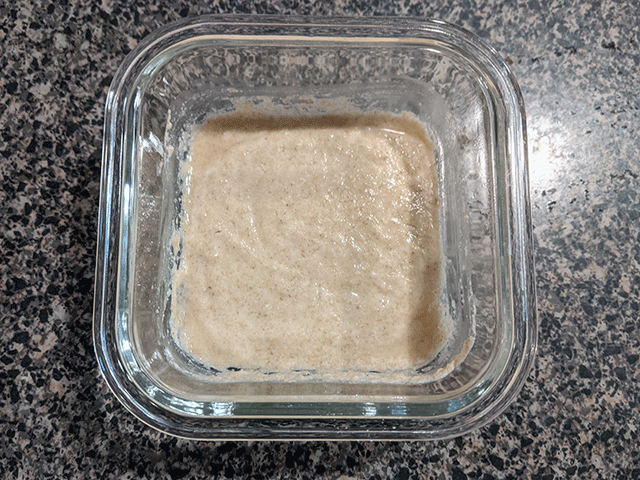
When you make a levain, you give your starter an extra amount of food and water. And when you let it sit overnight, you give it plenty of time to get active and bubbly and ready for working with in the morning.
10:35 PM – Autolyse the Wheat Flour
Whole wheat flour has bran that cuts through your dough and makes gluten development difficult. I found that a long autolyse time gives the bran a chance to soften. With a long autolyse time, your dough will stretch nicely during the stretch and fold process and will have a much more open crumb than if you skip the autolyse entirely.
Rye flour, in contrast, has a completely different structure than whole wheat flour. It does not need to autolyse at all, as it ferments quickly. A long autolyse process causes the rye to break down and deteriorate.
So for this recipe, we only autolyse the wheat flour with half the water. Combine 250 grams (2 cups and 1 tablespoon and 3/4 teaspoon) whole wheat bread flour with 225 grams (3/4 cup and 3 tablespoons) water until everything has been just moistened – but don’t knead the dough at this point. You’re not looking to develop the gluten at this stage.
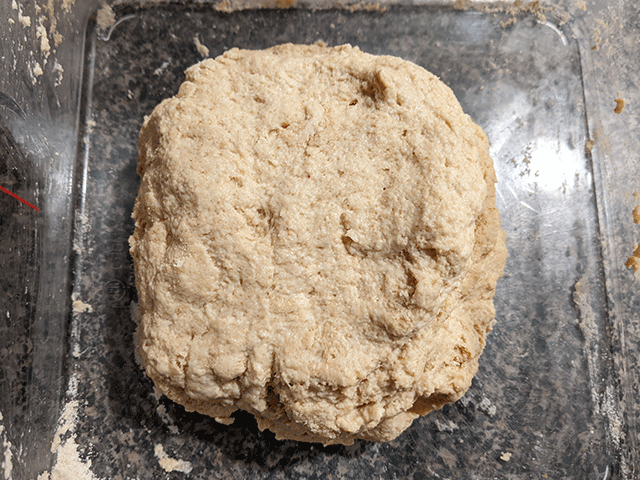
Cover the container and let sit overnight at room temperature.
And just as a heads up, my kitchen temperature tends to be a bit colder in the spring when I made this recipe. On average, my kitchen tends to stay between 68 and 70 degrees Fahrenheit (20 to 21 degrees Celsius). You may need to adjust your times if you have a warmer or colder room temperature.
Day 2 – Mix, Fold, Ferment, and Shape
Now that your levain has had all night to eat, it should be nice and active and bubbly – perfect for making artisan-style loaves. Additionally, your whole wheat flour will have soaked up a lot of the water.
10:30 AM – Mix in the Rye Flour, Remaining Water, and Levain
It’s time to get mixing!
Start with the 250 grams (2 1/4 cups and 3 tablespoons ) rye flour and the remaining 225 grams (3/4 cup and 3 tablespoons) water and mix thoroughly. Then add the levain and stretch and pull the dough around the levain, squishing and pinching as you go to ensure all the ingredients are evenly distributed.
The autolysed whole wheat flour may be a bit stiff to work with initially. But as you work in the rest of the water, it will loosen enough to blend with the rye flour.
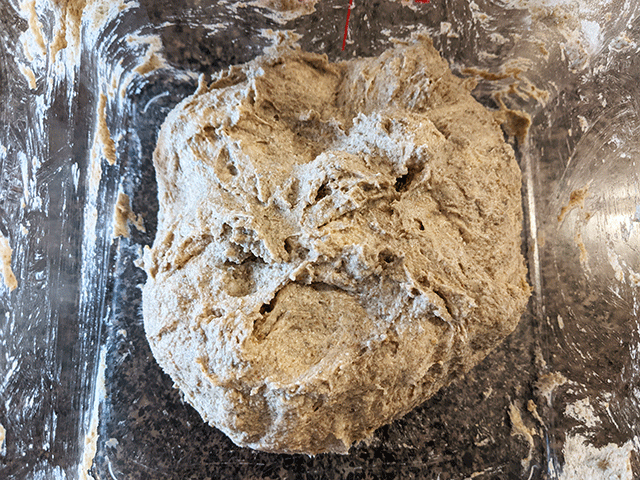
Don’t worry about shaping or folding your dough at this point. You just want to give the levain a chance to get working before you add the salt.
Cover and let rest for 30 minutes.
11:00 AM – Add the Salt and Caraway Seed
After your dough has had a chance to rest and your levain has had some time to activate, it’s time to add the salt. Sprinkle the sea salt and caraway seed over the top of the dough.
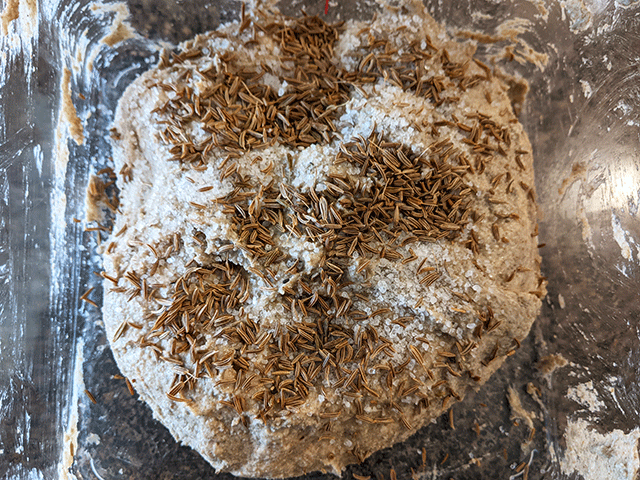
Then wet your hands a little, grab a corner of the dough and fold it over the top of the seasoning. The water on your hands will help keep the dough from sticking (for the most part), and it will dissolve the salt and soften the caraway seed.
Keep folding, squishing, and working the dough until the everything has been evenly distributed. Then, cover and let the dough rest for 30 minutes.
11:30 AM – 1:00 PM – Stretch and Fold the Dough
Rye flour has almost no gluten to support your bread, so the whole wheat bread flour (and vital wheat gluten if you’re using it) are going to be doing all the heavy lifting.
To strengthen the gluten, you’ll need to stretch and fold the dough. The more you stretch and fold your dough, the more it will behave like regular dough and less like a goopy mess.
Grab a section of the dough and pull it up toward you. Stretch it until you meet some resistance but do your best to not break or snap your dough.
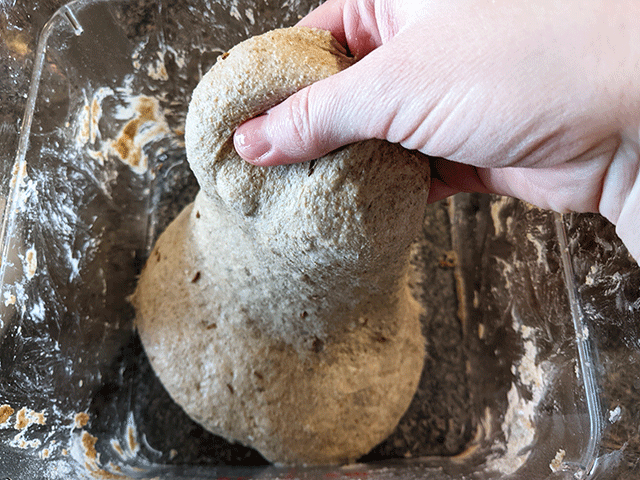
Fold that section of dough over the top of the rest, and then grab another section and repeat. You’ll want to continue stretching and folding your dough until it stiffens up a bit and starts to take on a round shape.
Cover and let your dough rest for 30 minutes.

Repeat the whole stretch and fold and rest process for a total of 4 times, each session 30 minutes apart. It’s fine if you have a slightly bigger or small time gap, so long as you give the dough time to relax and flatten in between each stretching and folding session.
Keep in mind that this is a high hydration dough with 50% rye flour. It will be sticky thanks to all the water and rye’s minimal gluten structure. Do not add flour. Simply wet your hands and keep going.
1:00 PM – 6:45 PM – Bulk Fermentation
This is my favorite part of making wheat and rye sourdough bread: fermentation.
All you have to do is keep your dough covered and let it sit.
Really. That’s all you have to do in this step.
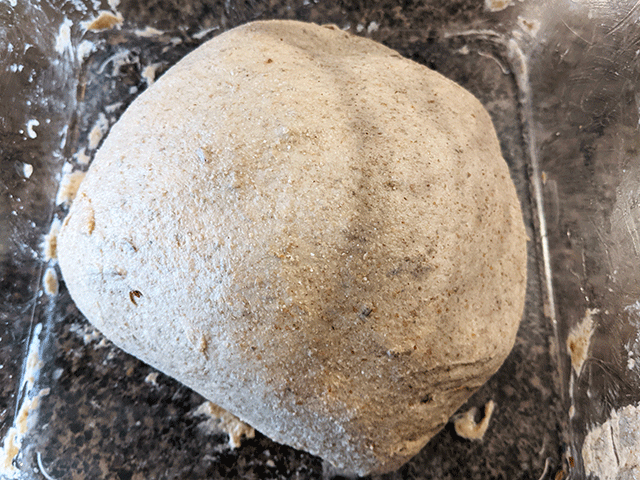
Your dough gets to do the hard work during this stage. Your sourdough starter will break down starches and release gas into the dough that will make nice air pockets in your wheat and rye sourdough bread later.
6:45 PM – Pre-Shape the Dough
If the previous step was the easiest step in this bread-baking adventure, then the next two steps are the most difficult (at least to me they are).
Pre-shaping and shaping the dough can make or break your bread’s final appearance. Good shaping will give your wheat and rye sourdough bread support during the final bake, enabling it to spring up in the oven rather than falling flat.
I’ve been playing around with artisan bread for years and I still struggle to shape properly. But hey, if I can shape a loaf, then so can you with a little practice.
To start, turn out the dough onto a clean surface – avoid flouring your bench if you can help it. Any flour you use in this stage might not mix properly into the dough and you might end up with flour pockets in your final bake.
Slide your bench scraper or dough cutter under one edge of the dough.
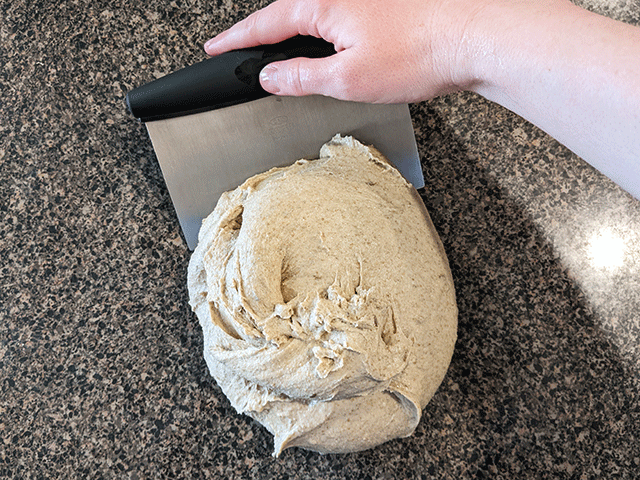
Next, turn your scraper like a steering wheel and push slightly into the dough. Your goal is to build tension in the dough as you work, but try not to push so hard that you break the skin.
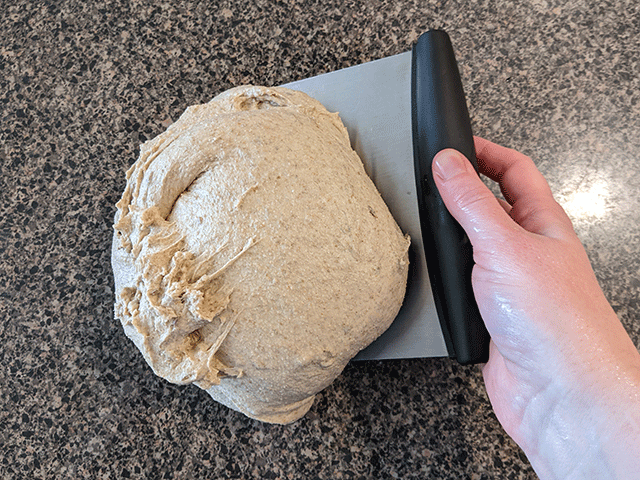
Now repeat! Slide under, turn, and push. Once you’ve gone over all the edges of the dough, you’ll end up with a nice dough round.
Cover your dough and let it rest for 15 to 20 minutes. The dough will relax a bit and may even lose some of its shape – don’t worry. You’re going to be shaping it again in the next step.
7:00 PM – Shape the Dough
Now this next bit can range in difficulty.
To Make a Boule (Round Loaf)
For a boule-shaped loaf, you can simply repeat your pre-shaping technique of sliding, turning and pushing to make a nice round again.
Start with one side.
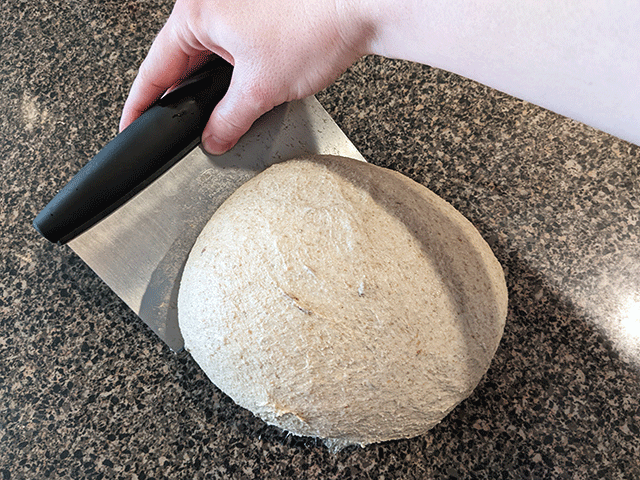
Then rotate and push with your bench scraper.

Repeat until you’ve gone around the entire round.
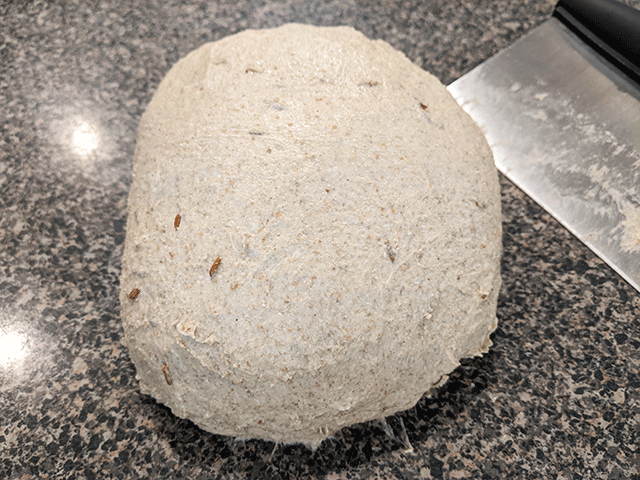
When you’ve finished making your round, use your bench scraper to flip the dough into a banneton basket lined with rice flour so the seam side faces up.
For a tighter round, you can stitch together your boule as pictured in my 100% whole wheat artisan-style bread recipe.
To Make a Batard (Oval Loaf)
If you want to make a batard (oval loaf) as pictured in the featured images at the top of this post, you’ll need to follow a few extra steps.
Keep in mind that this is difficult to do with a 50% rye loaf. The dough will be especially sticky and you’ll need to work fast. Wetting your hands will help, but in the end you’ll have to accept the fact that some of your dough will end up on your kitchen counter for cleanup later.
Use your bench scraper or dough chopper to flip your round back over and stretch it to make rectangle. Be gentle! If you’re too rough during shaping, you could ruin the fragile gluten structure that you worked so hard to build during your stretch and fold process.
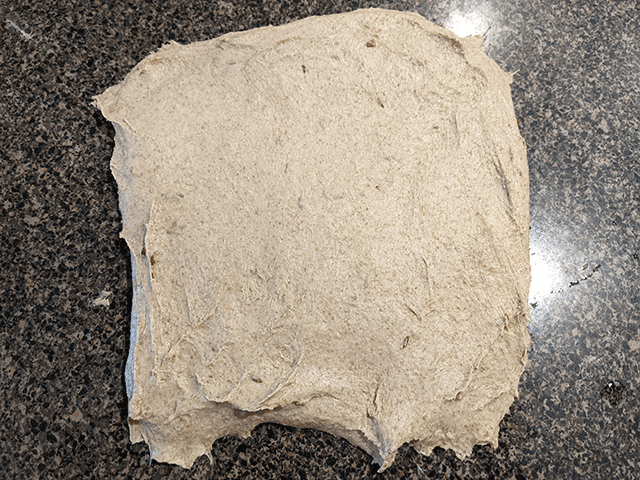
Wet your hands to keep the dough from sticking. Fold one side of the rectangle about one-third of the way across the dough, but angled. Then fold the opposite side. You’ll now have an elongated rectangle that looks a bit like a letter with one narrow end and one wide end.

Starting with the narrow end of your dough, use your hands to roll the dough up toward the opposite end. You want to roll the dough tight enough that you don’t create an odd air pocket, but not so tight that you break the skin of your dough.
I found that steady, confident movements help in this step. If you go too slow, the dough will have more time to stick to your hands. If you go too fast, you’ll end up with sloppy shaping.

Thanks to the wide end of your dough, you should have enough extra dough to cover the ends of your loaf. Pinch the sides together to create a seal. If the ends don’t want to go together, you may use a small amount of rice flour to give the dough some grip.
Grab your bench scraper and slide it under the dough. Flip it seam side up into a banneton basket lined with rice flour.
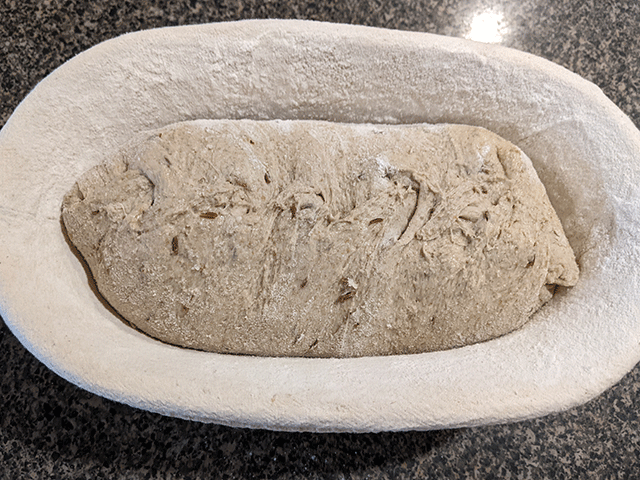
At this point, you have permission to use a little bit of rice flour for stitching up your loaf. I like to coat my fingers in just a bit of flour so I can grab an edge of the dough and pull it to the middle and get it to stick. Then I grab a small section of the opposite edge of the dough and pull it over the first section so there’s a slight overlap.
The goal with stitching your loaf is to create some tension in your dough without breaking the skin. A tight loaf will have a nicer oven spring.
7:10 PM – Retard the Dough in the Fridge
Once you’ve got your loaf all stitched up, cover and put it in the fridge over night. The colder temperatures will slow the fermentation process and help develop the rye and wheat flavor. My fridge is programmed for 40 degrees Fahrenheit (4 degrees Celsius). If you have a colder or warmer fridge, you’ll need to adjust how long your dough retards in the fridge. Warmer temperatures require shorter times, and colder temperatures need longer times.
I like to use Press ‘N’ Seal to cover my basket, but feel free to cover it with a plastic bag or even a resuseable bowl cover. Avoid using any kind of material that would breathe, such as a cotton cloth, because you don’t want the dough to dry out in the fridge. A dry dough will develop a skin that keeps the dough from rising.
Day 3 – Bake
You’re almost done! You’ve made it this far – you can make it the rest of the way.
If you were to take a quick look at your dough, you’d see that it will have risen somewhat in the fridge. Hopefully, it didn’t rise past your banneton, but it should have risen enough to be noticeable.
Additionally, the stitching likely relaxed a little into the rest of the dough. A close look should still reveal some stitching, but most of your dough will look smooth.
But don’t pop it in the oven right away! You need to do a few more steps first.
1:00 PM – Preheat the Oven and Dutch Oven
Parchment paper can keep your wheat and rye sourdough from sticking to your Dutch oven. But even with parchment paper, you shouldn’t bake your dough in a cold oven or it will stick to both the paper and your Dutch oven (believe me – I’ve made this mistake before).
At least 45 minutes before you’re ready to bake, preheat your Dutch oven inside your oven at 450 degrees (232 degrees Celsius).
1:55 PM – Score the Dough
When your oven has thoroughly heated, you can prep your loaf for baking via scoring the dough. A good score can open your loaf and allow steam to escape, giving your wheat and rye sourdough bread a better oven spring. Additionally, your score is a way of leaving your mark on your bread and giving it a unique look.
To start, turn your dough out onto high-heat parchment paper. Do not use cheap parchment paper, as it cannot handle the high temperatures and will burn in the oven.
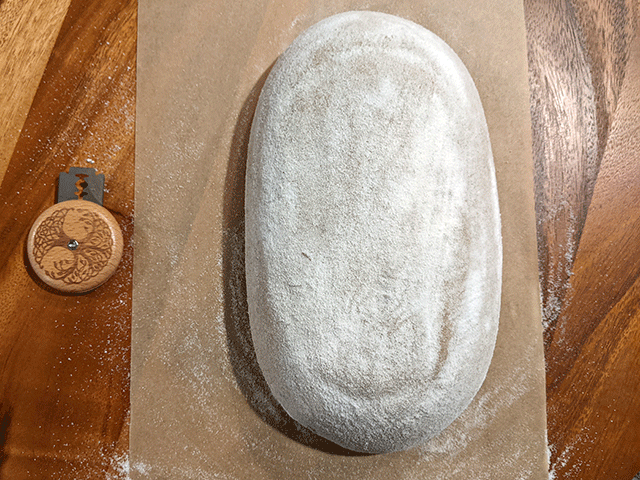
Brush off any excess rice flour (or feel free to sprinkle a little more rice flour if you want an even coat for color contrast).
Your wheat and rye sourdough bread will need at least one deep slash. And if you hold your bread lame or razor at a 30 degree angle, you can get that oh-so-gorgeous ear that artisan bakers love.
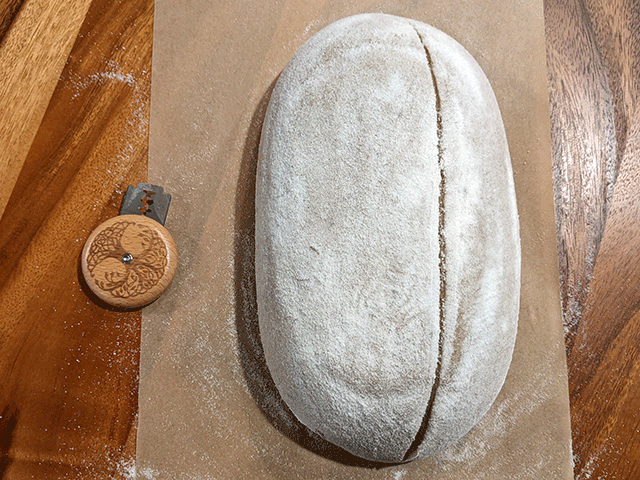
For the pictured loaf, I wanted to keep things simple and left it at the one slash. However, you can get more artistic with your bread and make a few more shallow slashes to create intricate designs.
Keep in mind that for decorative cuts, you want to just barely break to skin. Deeper cuts will result in larger splits.
2:00 PM – Bake and Cool
Oven and Dutch oven heated? Dough scored? Great! You’re ready to bake.
Quickly and carefully remove your Dutch oven from the oven and take off the lid. Use your parchment paper to transfer the dough to the Dutch oven.

Place an ice cube underneath the parchment paper and quickly cover your loaf with the Dutch oven lid to trap in the steam. Put your Dutch oven back in the oven and let your bread bake for 25 minutes at 450 degrees Fahrenheit (232 degrees Celsius).
After 25 minutes of baking, remove the Dutch oven lid. Your wheat and rye sourdough bread is not done at this point, but it will have sprung up quite a bit by now.
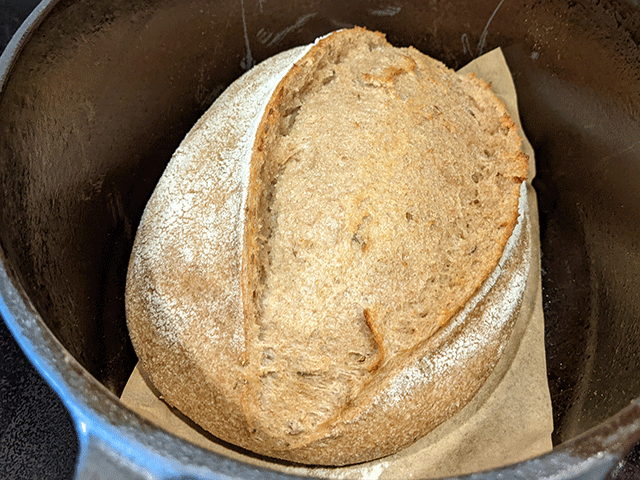
Continue baking your wheat and rye sourdough bread at 450 degrees Fahrenheit (232 degrees Celsius) for 20 minutes. Your crust will darken and crisp up. Aim to bake your bread until it is just shy of looking burnt to ensure the crust caramelizes.

When your bread has finished baking, turn it out onto a wire cooling rack. But do not cut into your loaf!
Although wheat and rye sourdough bread fresh from the oven seems like a tasty idea, your loaf hasn’t finished baking. The interior of your bread will continue to cook from its own residual heat. Additionally, rye’s unique structure requires additional cooling time to properly set.
If you were to cut into your loaf prematurely, your bread would have a gummy, tacky texture and it will stick to the knife. Give your loaf at least 4 to 5 hours before cutting into it, though ideally, you should wait at least a day for the best flavor and texture.
Additionally, wait until your bread has finished cooling before storing it in a plastic bag. If you store it too soon, the wheat and rye sourdough will sweat and soften the crust (which also has its perks but shortens its shelf life).
Day 4 – Slice, Serve, and Store
Assuming you exercised some self restraint, your wheat and rye sourdough bread is now ready for slicing and serving. Feel free to eat your bread toasted or turned into sandwiches – the possibilities are endless!
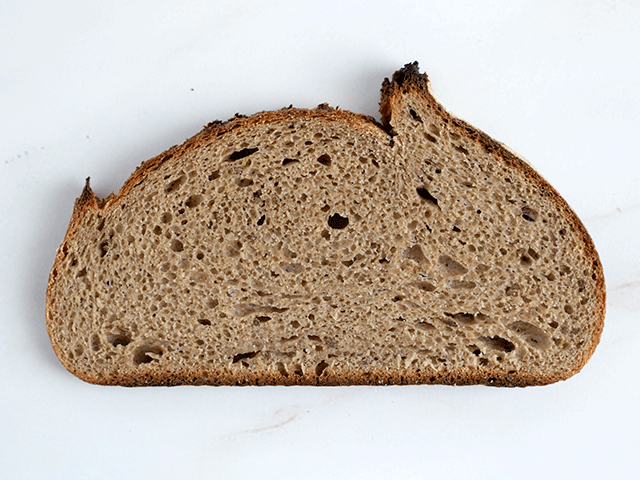
Freshly baked wheat and rye sourdough bread can last at room temperature for about 5 days when sealed in a plastic bag at room temperature.
Do not store your bread in the fridge, as the cooler temperatures will make the bread go stale faster. If you must refrigerate your bread due to lack of space or high humidity, your bread will only last about 2 to 3 days before it goes stale.
If you plan to freeze your bread, wrap it in aluminum foil, freezer-friendly plastic wrap, or a freezer friendly bag. When properly stored, your wheat and rye sourdough bread will last about 3 months. To thaw, place in the refrigerator overnight and then pop it in the oven at 325 degrees Fahrenheit (162 degrees Celsius) until heated through and slightly crispy.
Just the Basics

50/50 Wheat and Rye Sourdough Bread
Ingredients
Levain
- 2 Grams Sourdough Starter (1/2 Teaspoon)
- 18 Grams Whole Wheat Flour (1 Tablespoon and 1 Teaspoon)
- 20 Grams Water (1 Tablespoon and 1 Teaspoon)
Dough
- 250 Grams Whole Wheat Bread Flour (2 Cups and 1 Tablespoon and 3/4 Teaspoon)
- 250 Grams Rye Bread Flour (2 1/4 Cups and 3 Tablespoons)
- 450 Grams Water, Divided (1 3/4 Cup and 2 Tablespoons)
- 14 Grams Fine Sea Salt (2 Teaspoons)
- 7 Grams Caraway Seed (1 Tablespoon)
Instructions
Day 1
- 10:30 AM – Feed your starter 40 grams whole wheat flour and 40 grams water.
- 10:30 PM – Make your levain and autolyse your wheat flour with half the water.
Day 2
- 10:30 AM – Combine your levain, your rye flour, and remaining water. Let rest for 30 minutes.
- 11:00 AM – Add salt and caraway seed and mix well. Let rest for 30 minutes.
- 11:30 AM – 1 PM – Stretch and Fold dough 4 times with 30 minute breaks between each session.
- 1 PM – 6:45 PM – Bulk fermentation.
- 6:45 PM – Pre-shape dough. Let rest for 15 to 20 minutes.
- 7:00 PM – Shape dough. Transfer to banneton basket. Cover and retard in the fridge.
Day 3
- 1:00 PM – Preheat Dutch oven inside the oven at 450° Fahrenheit (232° Celsius) for 45 minutes to an hour.
- 1:55 PM – Turn dough out onto parchment paper and score.
- 2:00 PM – Bake bread for 25 minutes with Dutch oven lid on.
- 2:25 PM – Remove lid and bake for 20 minutes.
- 2:45 PM – Turn bread out onto a wire cooling rack and allow to cool completely.
Day 4
- Slice and enjoy your bread!
Notes
Secrets to Success
Whole wheat flour is infamous for being difficult to work with. Most artisan-style recipes recommend combining wheat flour with all-purpose flour to give it an airy texture and crumb.
Similarly, rye flour is infamous for being difficult to work with. Rye flour lacks the gluten structure that wheat flour offers, so it often falls flat unless mixed with all-purpose.
Combining both flours creates a unique challenge. If not done correctly, you’ll end up with a flat, brick of a loaf. Over proofing will result in a breakdown of the already limited gluten network, and under proofing won’t give your gluten a chance to form.
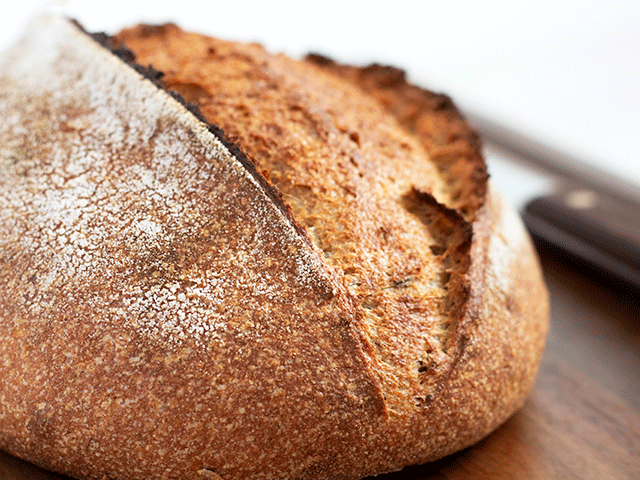
To get this wheat and rye sourdough recipe just right, you have to understand how both rye flour and wheat flour works. Wheat flour requires a lengthy autolyse time while rye flour shouldn’t be autolysed all. With both flours, they need a lot of water to soften the bran, so it needs a high hydration to ensure a more open crumb and oven spring.
Trouble With Sticking?
High hydration doughs like this one are sticky and difficult to shape. If you’re new to artisan-style sourdough, you might struggle to get picture-perfect loaves. For best results, you’ll need to practice, practice, practice – consistency is key! Eventually you’ll get a feel for how the dough should look while you shape.
To minimize sticking, work quickly as you shape. The longer you let the dough linger on a surface, the more time your dough has to stick. If needed, wet your bench scraper as you shape.
If your dough sticks to your Banneton basket, make sure you use a liner and liberally dust it with rice flour. Rice flour sticks less than other flours and you can brush off the excess before baking.
Do not use extra wheat, rye, or all-purpose flour to dust your work surface. The flour will get folded into your dough but will not get absorbed, resulting in powdery flour pockets in your bake.
Trouble With Large Holes?
Large holes are a common problem with artisan-style loaves, and they can result from a number of factors.
If your loaf has several large, gaping tunnels when sliced, you’re likely under proofing your wheat and rye sourdough bread. Give your dough an extra hour or two in the fridge and see how that affects your dough. You may need to play around with your timing if you have a hotter or cooler kitchen than mine.
If your loaf has one or two large holes, they may be the result of poor shaping. As you shape, you want to pop any large holes that grew during bulk fermentation.
If your loaf has a scattering of smaller holes near the edges, you might be baking at too high of a temperature or you might need to score your dough a little deeper. High temperatures will harden the crust too quickly and the air won’t have a chance to escape. A deeper score will also allow gasses to escape during baking, resulting in better oven spring and a gorgeous ear.
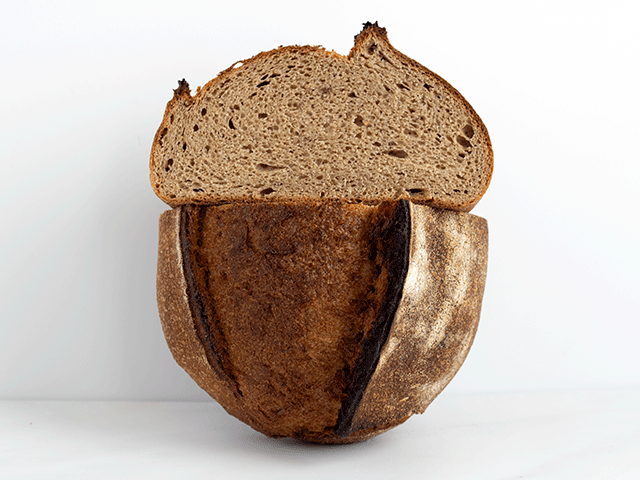
Take Notes
I tried to take the guesswork out of baking this tough recipe. However, I understand that each kitchen is different. Your kitchen may be hotter or colder than mine. Similarly, your refrigerator and oven might run hotter or colder, and you’ll need to adjust your recipe to compensate for those differences.
As you make changes, take notes! See what works best for you.
If you want a more open crumb, you may need to bump up the hydration and then reduce your levain. If you struggle with the current hydration, you may need to decrease the hydration and extend your fermentation time.
Once you’re happy with your results, feel free to share what you’ve learned in the comments below. Your tips can help other beginning bakers on their baking journey.
Nutritional Information
My wheat and rye sourdough bread recipe has plenty of fiber and protein thanks to the whole wheat flour. If you’re curious about its nutritional information, here’s a quick peek at what you’re getting:

Keep in mind that I cut my batard loaf into 10 slices. If you made a boule, your slices will vary in size and your nutritional information will reflect that.
Did You Try It?
I know wheat and rye sourdough recipe can seem complicated at first, but it’s well worth the effort. If you tried my recipe and liked it, please give it a star rating so others will see it and try it, too. If you have suggestions for improving my recipe, please share them in the comments section below. Your feedback helps make good recipes into great ones.

